Against an internal enemy. Security and Police Service of the Varangian Guard
Anna Komnina noted that the soldiers of the Varangian Guard were much more loyal to the emperor than the Byzantines. And the lizards were betrayed rather the status of the sovereign and the imperial power, rather than the identity of the basil. Therefore, when the emperor-warrior Nikifor Fock was attacked, the guards, breaking the door to assist him, hearing about the death of the sovereign, stopped breaking through and then did not interfere with the proclamation of a new basil - John Tzimshiy. When, having bribed the Germans, in March 1081, the challenger to the imperial throne, Alexy Comnenus, entered the capital, the varangians remained loyal to the current emperor, Nikifor III Votaniata. But the latter decided not to start a civil war and abdicated. With regard to the fidelity of the Varang, a similar situation occurred in 1203-1204. Therefore, no matter how paradoxical it may sound, the Varangian Guard (consisting of non-Byzantines) served the state of Byzantium, and not a specific monarch — that is, “a house, not a master.”
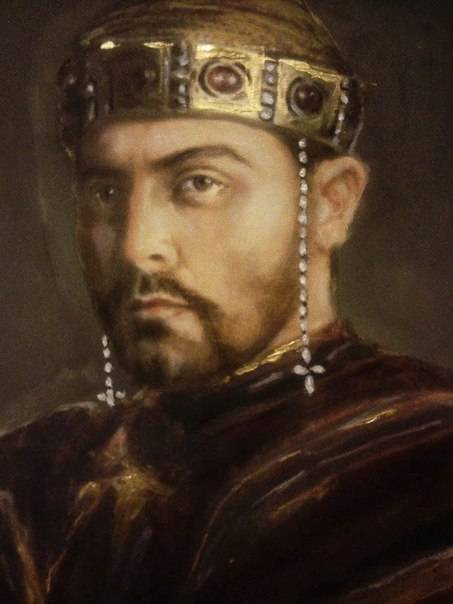
1. Nicephorus II Phocas. Modern image.
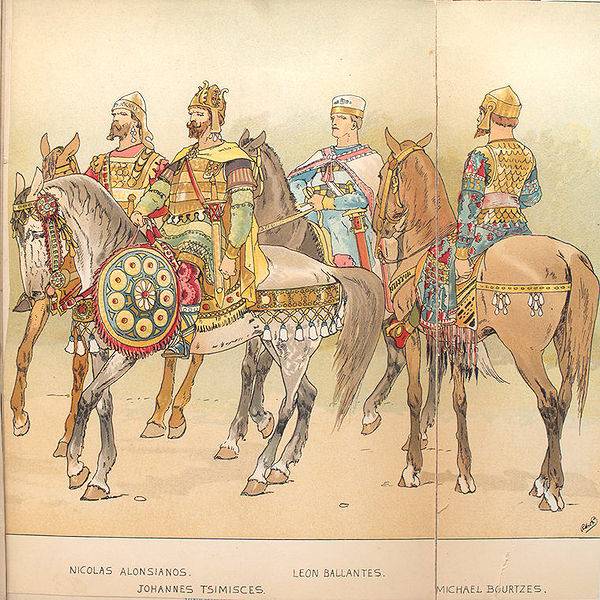
2. John Tzimiskes with military leaders. Winkuizhen Collection
Vasily II, one of the greatest monarchs of Byzantium, remained on the throne almost exclusively due to the actions of the 6-thousand corps of Rus sent by Prince Vladimir. Rus became the savior of Byzantium, which was at that time a stronghold of Orthodoxy. And it is not surprising that the Rus became the forefathers of the most elite part of the imperial guard.
Almost every Guards formation of this era as the main task had the protection of the first person of the state, members of his family and the most important government agencies.
The main objects of the guard service of Varangi are the imperial residences (first of all - the Grand Palace), the Vlacherna Palace, the reception rooms and the personal cabinet of the basil. And, of course, the primary task of Varangi (the successor of Excursors) was to ensure the personal security of the head of state - the protection of the emperor's personage. The Varangian guardsmen controlled all the movements of the sovereign, both on state and private affairs, guarded him in the church, in the theaters of military operations, etc.
What are the most outstanding services of the guards when defending the imperial throne?
In 1044, the city of Varang defended Constantine IX Monomakh - an indignant crowd believed that the latter was trying to destroy the "royal sisters" - her husband Empress Zoya and her sister Theodora.
3. Zoe, Constantine and Theodora (Sinai collection of sermons by I. Chrysostom, XI century.).
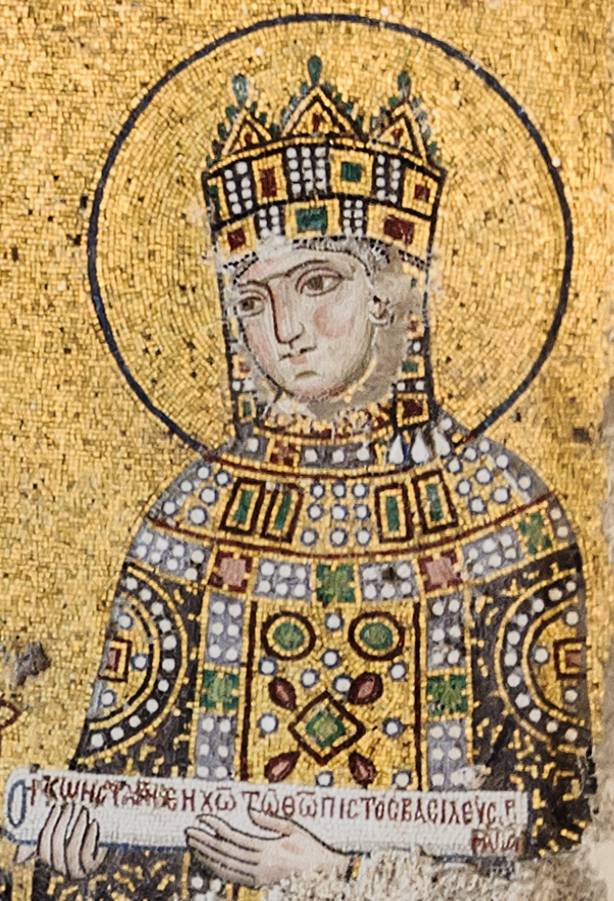
4. Zoya (ca. 978 - June 1050) - Empress of Byzantium in 1042, daughter of Constantine VIII and wife of 3 emperors (Roman III, Michael IV and Constantine IX) - all three ascended the throne thanks to this marriage. After the death of 2, her husband was forcibly tonsured into a nun, but after popular unrest, she again led the empire with her sister Theodora, and then married for the third time. Mosaic in Hagia Sophia.
The Varangian guardsmen and the attempt on Constantine himself were prevented: when the imperial procession was returning to the palace from the theater, the murderer, mingling with the guards who were closing the procession, entered the palace chambers, sitting in ambush near the kitchen. Surrounding people saw this person, but thoughtlessly they thought that since he was in the palace, it was certainly by imperial order. After the emperor fell asleep, the murderer took out a sword hidden on his chest and tried to carry out his plans. But the emperor did not have time to wake up, as his guardsmen had already “tied up” and interrogated the attacker. [Psellos M. Decree. cit. C. 115].
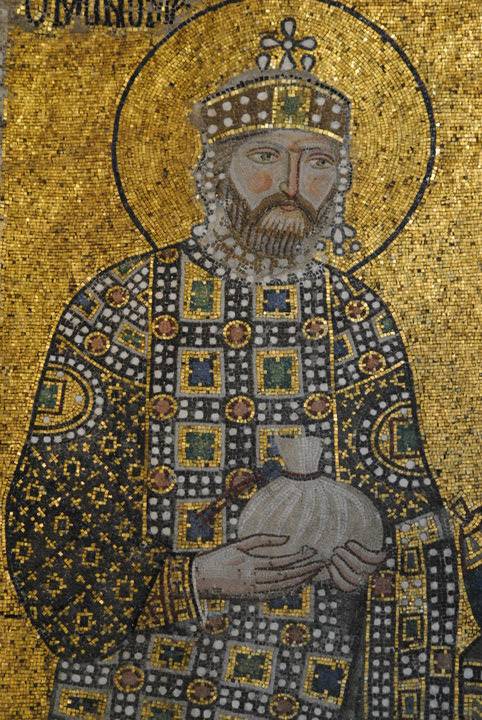
5. Konstantin IX Monomakh (ca. 1000 - 11. 01. 1055) - Emperor of Byzantium (11. 06. 1042 - 11. 01. 1055) from the Macedonian dynasty. During his reign in 1043, the last (and only after baptism) campaign of Kievan Rus to Constantinople took place. Mosaic in Hagia Sophia.
Varangi also took part in disrupting the conspiracy of Solomon against Alexey I Komnin.
In 1154, the 300 Varang played a key role in eliminating the assassination of Manuel I Comnenus.
Having risen in 1185 on the path of the uprising against Andronicus I Comnenus, Varang almost completely perished.
In 1200, the Varangian Guardsmen prevented 2 from overthrowing Alexei III.
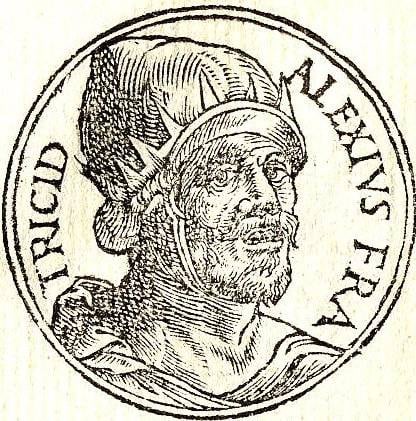
6. Alexey III Angel (ca. 1153 - 1211) - Byzantine Emperor in 1195 - 1203 Fig. Sat 1553 biographies
Immunity from the sympathies of the military elite, the nobility and the local population, as well as devotion to the sovereign made the Varang especially useful for such a delicate task as taking into custody those with a high aristocratic or religious status. For the same reasons, they were used as jailers - primarily in the terrible prison of Numera, which was located in the imperial Grand Palace. It is no accident that pictorial sources as guards in the scenes devoted to the betrayal of Christ demonstrate precisely the warangs.
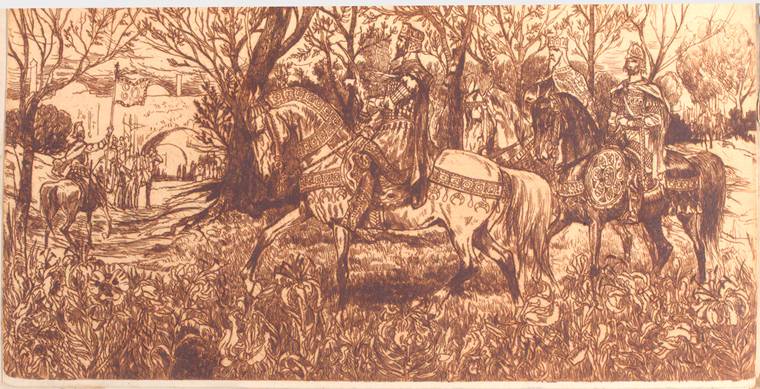
7. Byzantine grandees with retinue. 10 century. Winkuizhen Collection.
Repeatedly guards and put things in order during the unrest of Constantinople.
Varanga acted most efficiently by eliminating insurrections — she went into battle from the moment she was formed. In 988, Barda Foka’s insurgents were defeated at Chrysopolis. 13 April of the following year won the first serious battle. And he was also given to the internal enemy, the Phocasians under Abydos.
At this time, the backbone of the Emperor Vasily II Guard were Russes. Having landed under Lampsak, they engaged in battle with the Georgian guard Warda Foki - and won. There is an opinion that Prince Vladimir was also in the Russian corps at that time. [Levchenko M.V. Relations between Byzantium and Russia under Vladimir / Byzantine temporary. 1953. T. 7. C. 206].
Thanks to the Varangian Rusas, the head of Warda Phocas was mounted on a spear, and Basil succeeded in becoming enthroned on the imperial throne. As Leo Deacon noted, the usurper marveled at the mobility of the imperial forces. Ward Fock came out of the fortification to meet the troops of Vasily and, being in the space separating the troops of the opponents, suddenly fell from the horse - and his head was cut off.
In 1009-1011 near the southern Italian city of Bari, the Varangians are fighting the insurgent forces of Melos. The latter tried to create a republic - but his opponent acted more quickly. In June 1011, after a series of battles, the city returns to the bosom of the empire.
In 1018, the 2-I Byzantine campaign against Melos from Bari took place - the forces of the Italian katepana went on the offensive. And in 1019, in the area of the famous Battle of the Second Punic War, the battle of Cannes took place - and a turning point in this battle (which ended in the crushing defeat of the allies of the rebels, the Normans of Gilbert) was made by a detachment of Russian Warangas. As the source noted, the emperor sent his best fighters against the brave knights. The result was quick to say - even in the first 3 battles with the Byzantines, the Normans won, but when confronted with the Rus they were utterly defeated. The Norman army was almost completely destroyed.
In 1038, a revolt flared up in Bari. The struggle with the Lombard uprising continued with a varying success 3 of the year - until in the 1041 the cathepane Michael Duca arrived in Italy with additional troops, which included Varangi and its subunits. During the year, the 3 battles took place - at Olivento (March), Montemaggiore (May) and Monte Peloso (September). Lombard infantry was actively helped by the Norman cavalry.
Varangian units proved the ability to conduct combat operations of high intensity. Along with the Varangian contingents, the troops of the Opshion and Thrace fought with the rebels and their allies.
But the army of basil was waiting for a heavy defeat in the battle with the Normans at Montemaggiore. The 2000 of the Normans' mounted horse broke the Byzantines who outnumbered them. The combat order of the latter consisted of 2-x echelons. The Norman knights rammed the ranks of their adversary — probably having built a wedge. Alternately breaking through the stretched construction of the Byzantines, heavy cavalry turned them to flight. During the retreat a large number of warriors of the emperor drowned in the spilled river. Ofanto. Many Varangian Guardsmen fell in the battle, but Harald Hardrada managed to escape.
In 1040-1041 George Maniak fights against the uprising of the Bulgarians under the leadership of Peter Delyan. Initially, the uprising was successful. Peter Delyan in the summer of 1040 was proclaimed king of Bulgaria, and the uprising quickly swept a large part of the Balkan Peninsula. Having established themselves in Dirrachii, the rebels sent their detachment to Greece — he reached Thebes and defeated the Byzantines.
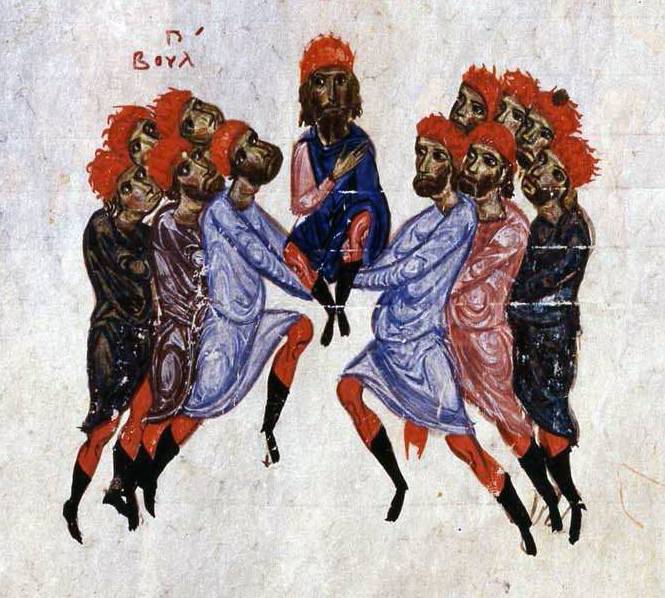
8. Peter II Delyan (d. 1041) - the leader of the anti-Byzantine uprising of the Bulgarians, which began in the summer of 1040 in the Pomoravle region (modern Serbia). As the grandson of Samuel, he was proclaimed king of Bulgaria (the summer of 1040), but the Bulgarian forces were defeated in the Battle of Ostrovo.
Moreover, the Nikopolitans attached to the rebels - and its residents killed the tax collector. Rebel detachments appeared in the vicinity of Solun. But after an unsuccessful attempt to take Thessaloniki, luck turned away from Peter Delian's troops. The uprising ended in surrender to the imperial troops - Harald's detachment acted as part of the latter.
While in Italy, George Maniak fell out of favor, and was recalled to Constantinople. He did not obey and proclaimed himself emperor - eventually he died in the battle of the Island. During the latter, Maniak was opposed by several Varangian units. When in Constantinople, in honor of the victory over the troops of G. Maniak, a triumphal procession took place, then, following the formation of the Vikings with axes on their shoulders, they carried the head of a man who led the imperial troops to victories over the Normans and Arabs.
True, among the Varangian Guardsmen, George Maniak was always not very popular. M. Psella noted that this great commander and worthy man was haunted by rock all his adult life. He slowly moved up the corporate ladder, but as soon as he reached the top military posts, as soon as he was decorated with a triumphant wreath, he found himself in chains. Returning to the emperors, the winner was in jail. He was again sent on a campaign as a commander, but the "milk warrior commanders" pushed him on the wrong path, threatening grave consequences. Mr. Maniak took Edessa, but he landed himself under investigation, almost conquered Sicily - but in order not to allow him to completely seize the island, the commander was called off in disgrace. M. Psellos noted that he had personally seen this man and admired him. In it, nature has concentrated all the qualities that were required for a true commander. [Psellos M. Decree. cit. C. 94].
1047 was the year of the Leo Tornik rebellion. The forces of the opponents were unequal - many volunteers and mountaineers joined the ranks of the rebels, who had not yet approached the city walls. In the imperial camp, things were different: the army was not assembled, except for the “small detachment of foreigners,” usually marching in royal processions (this is a division of Varangi - AO) Ibid. C. 104). As a result, L. Tornik capitulated and was blinded.
In 1055, the Varangs took part in the elimination of Theodosius’s coup attempt.
20. 08. 1057 after the battle of Petro (near Nicea) Michael VI abdicated the throne in favor of Isaac Comnenus. Varangian troops were in the troops of both opponents. In this battle, Isaac, according to legend, successfully opposed 4 Varyags.
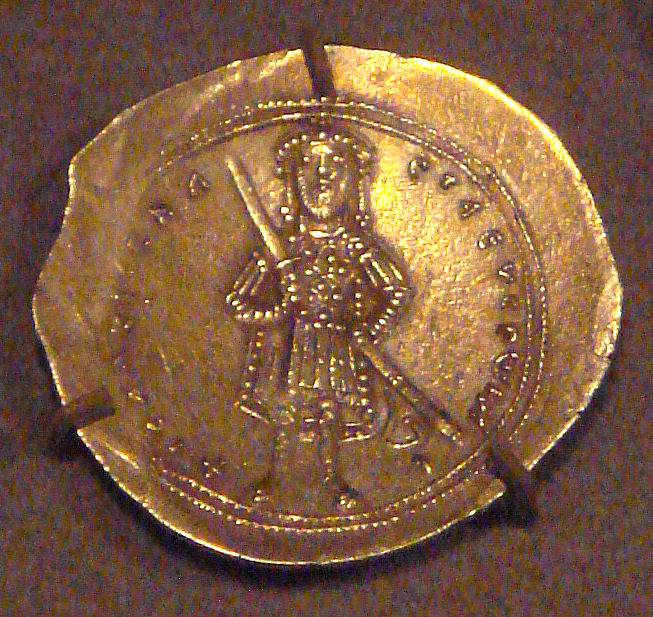
9. Isaac I Komnenos (ca. 1005 - 31. 05. 1061) - Emperor of Byzantium in 1057-1059. Image on the coin
1077-78 - battles with the rebels Nikifor Vryennius and Nikifor Vataniat are fought again.
Varyags effectively exercised police functions at sea. So, Harald with his squad, acting in the Aegean Sea, successfully resisted the Arabs' raids on the coast. It was during the reign of the naval strategist Roman III (1028-1034) that the naval might of the empire was reborn. Harald Sigurdson noted in his saga that by paying to the treasury from every captured pirate ship 100 coins, the rest of the loot could be kept. Probably, the Vikings were part of the garrison of the Paphos naval base, located in Cyprus. The fight against piracy has become an ideal task for the Vikings, who were born sailors, pirates. Before the siege of Bari, in 1068-1071, warangs patrolled the coastline of Apulia.
Sometimes (extremely rarely) Varanga itself was a source of instability. So, in 1057, she played a decisive role in the coup d'état - as a result, Michael VI on the imperial throne was replaced by Isaac Comnenus. The precedent occurred for the first time after 988 - for the first time, the Varangian Guard, always loyal to the sovereign, was not up to par. It is quite possible that the fact that the Varyag-Russes, wholeheartedly devoted to the basil, ceased to dominate in Varang, worked. And at this moment there was a delimitation in the guard itself - the chronicler noted the opposition of the Russian and 2's Norman tagmat. Impetuous, fast and uncontrollable Normans came out against the furious and ferocious Rus, armed with long spears and axes.
But this is an exception to the general rule - and the Varangian Guard was a sure support of the imperial power throughout its entire service of the Byzantine Empire.
10. Varangian guards during the Constantinople palace twists and turns. Fig. John Skylitsa.
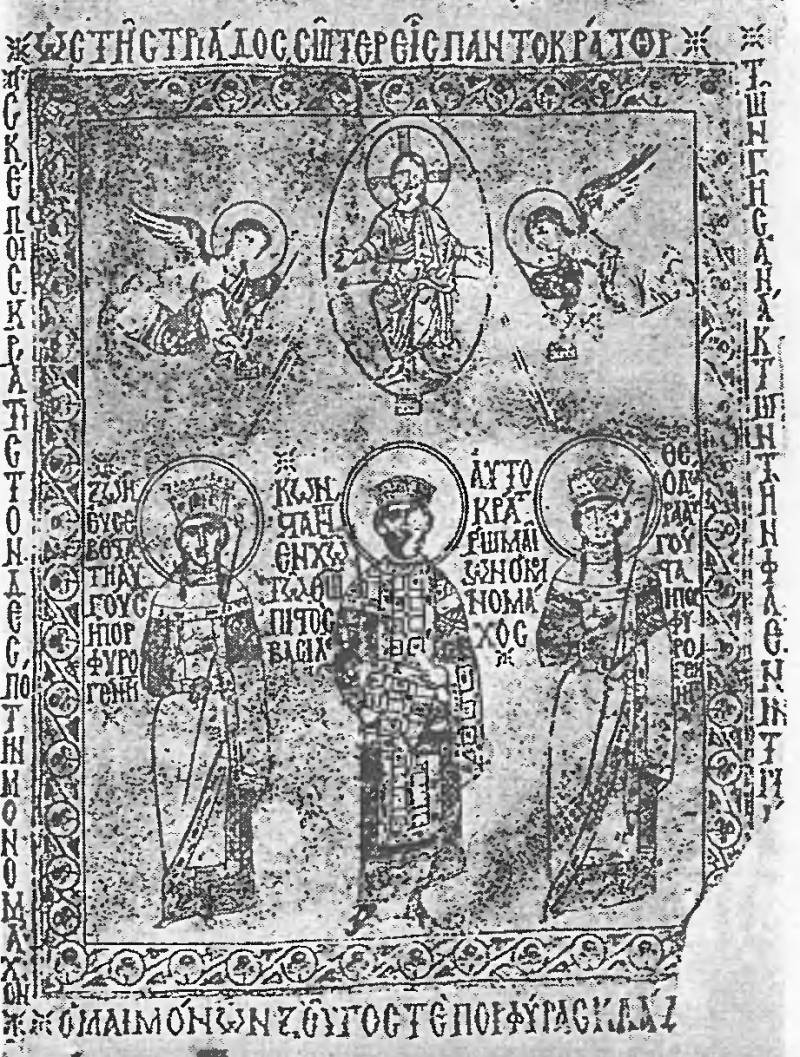
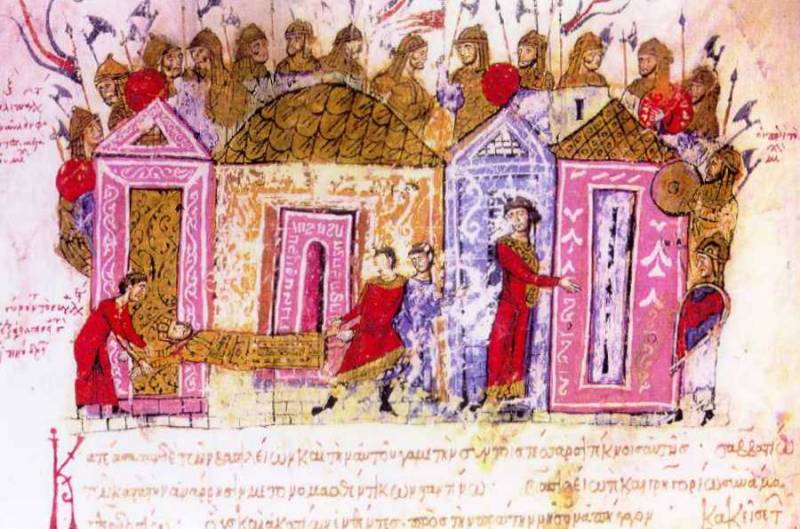
Information